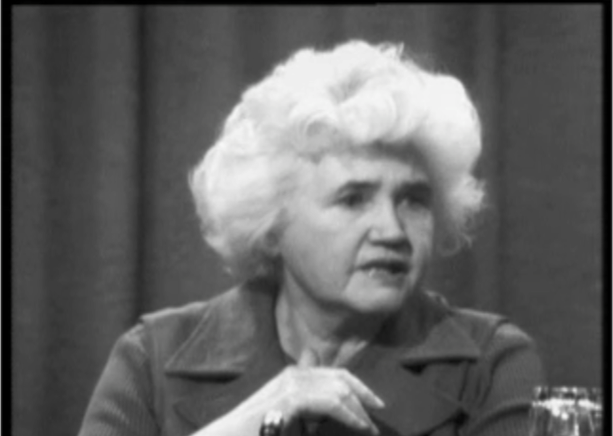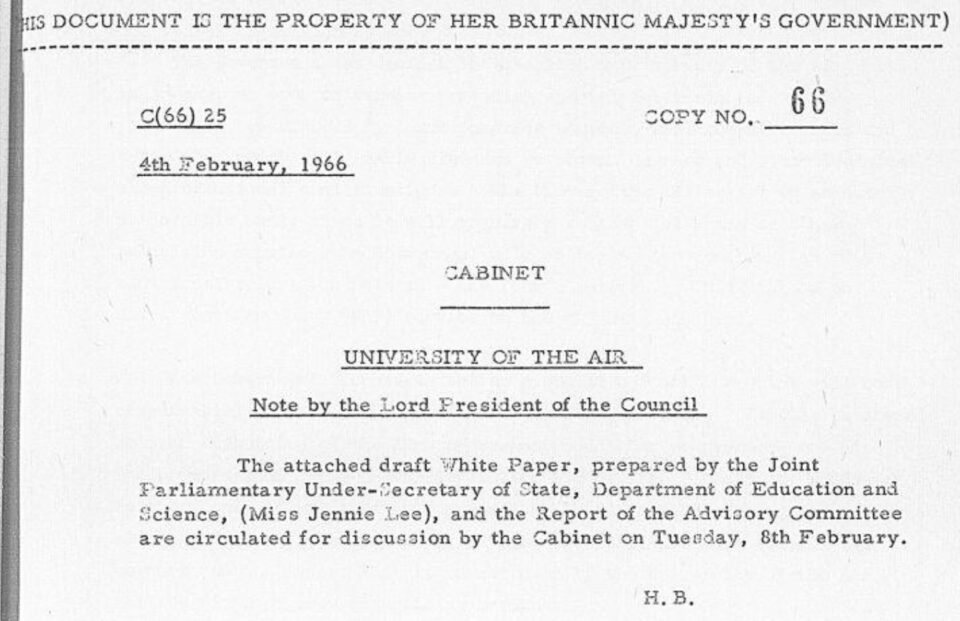We’ve been teaching design at the OU since its beginning in the 1970’s. So it’s always been fascinating to me how you design a thing like The Open University?
And trust me, the OU was designed. If you look at the history of the the early vision and ideas for the OU, you can see the design scars everywhere.
So, let me introduce you to the first designer of the OU: The Rt Hon The Baroness LEE of Asheridge. Or Jennie Lee, as she’s more commonly known:

I’d argue that Jennie Lee acted as a designer because it was her work (ideas and effort) that translated a rather vague early vision for a ‘university of the air’ into a reality. That, for me, is the real definition of a designer – someone who goes beyond just coming up with ideas and sees them into implementation.
But more that this, I’d argue that Jennie Lee was a fantastic design manager. This is because she put in place the conditions by which a vision of reality would come into being. She didn’t create ‘a design’ – she designed the opportunities and chances for a design to happen, encouraging those around her into that space to make sure it did happen.
Let’s take a look at how she did that. (By the way, this all comes from some of the OU archive material available on the superb (and freely available!) OU Digital Archive.)
Vision
Before we get to Jennie Lee’s role, it’s actually slightly easier to start with the OU’s Vision, or Mission. This hasn’t changed much in 50+ years and it’s still on the front page (albeit at the bottom…):
“Our mission is to be open to people, places, methods and ideas—and as such, equality and diversity are at the heart of everything we do.” (The Open University, 2025)
This vision comes from Lord Crowther’s speech at the inauguration of The Open University (Crowther was the OU’s Foundation Chancellor). For some of us, the words are still pretty important (you can hear the full speech here). It contains some really powerful words, ideas, and rhetoric:
“Wherever there is an unprovided need for higher education, supplementing the existing provision, there is our constituency. […] There are no limits on persons.” (Crowther, 1969)
This sort of vision represented by a sentence like “Open to people” is important for an organisation to focus on and create an identity around. But it’s also strangely meaningless. It sounds good, but what does being ‘open’ to people actually mean? And I mean in practical terms? Crowther, gives a clue as to what really was behind this sentiment – an under-representation in education of large parts of UK society at that time.
The problem with visions is that they are shared. That means they can have different meanings for different people (sometimes, even at different times in the same project!). This can be a huge weakness or strength depending how visions are put to work…
And I’m pretty sure that Jennie Lee understood that. At the very least, she acted with an understanding of it. If you look at what actually happened and how the OU started, it’s very clear that it did not start with a vision clearly defined and written down. That came much later and as a result of how Jennie Lee went about designing the early OU…
So, here are a few characteristics of this type of design management approach, applicable to small and large design projects.
Guiding Principles – Agency
Jennie Lee made sure that the people working with and for her had space to do their job. Baroness Lee did not try to do people’s jobs for them. She did not micro-manage (OK, with a few exceptions!); she did not dictate what people were to do; she did not pretend to be an expert in something she knew nothing about.
In fact, this comes from a key starting position and management strategy that Jennie Lee refers to in her talk, quoting a senior civil servant at the time:
“ ‘It’s not our function to decide what to do, we must decide how to do it. These are the instructions from the Prime Minister, from the Cabinet, and it’s to this that we’ve got to give our minds.’ ” (The Open University, 1975)
By this, Lee means that her focus was on delivering this vision – not questioning it. A lot of wasted time is taken up by questioning decisions and this is almost always because the proper time for those questions (during the creation of the vision) is rarely undertaken properly.
But forget the outcomes from this for a moment and consider this as a design ‘move’. That is, Jennie Lee set up a Guiding Principle (Lawson, 2005; 2005) that she used to determine her management approach. And this was central to what then happened.
How a project makes use of vision, such as through Guiding Principles, makes a huge difference to how a vision is realised in reality.
Project setup and start
Jennie Lee was tasked by Harold Wilson to create the ‘University of the Air’. At the time, this was a vague and unconvincing dream that included notional ideas such as “education”, “technology”, and “world leader”.
Jennie Lee is silent on the matter, but I suspect one, if not two, eyebrows might have been raised during the initial meeting and pitch. Or maybe not… Jenni Lee had worked with Wilson on a prior project and they understood how to work with one another very well: one was able to offer an idea and then trust the other to see it developed into a vision.
The first critical steps in setting out a working relationship and the subsequent trust between any designer and client is critical to how successful a project will be. Jennie Lee was clear from the start:
“I work only with you. I negotiate directly with the Treasury … and you help.” (The Open University, 1975)
This partnership and project setup was critical to the early formation of The Open University what it became. This is something that is often missed in project starts. We very often create a new project folder, tidy up our desk a bit, and start the next project in the same way we did the last one. But projects, and particularly large, vision-driven projects, are really susceptible to initial conditions.
How a project starts has a HUGE impact on how it proceeds and whether it succeeds or fails.
Uncertainty and ambiguity
Allowing uncertainty and ambiguity for the right length of time and in the right places.
Another key condition Jennie Lee allowed for was uncertainty and ambiguity. There is absolutely no point in engaging in a design process if you know what it is you want or need. And in creating something very new, the last thing you need are too many conditions.
“Perfectly properly they wanted to know how much all this was going to cost. And I couldn’t tell them. I hadn’t a clue. And neither had anyone else. […] there’s a lot of wild guessing often in the early stages.” (The Open University, 1975)
At the same time, you don’t want a project to wander too much or have absolutely no boundaries. Conditions, constraints, and considerations are very often what allow ‘creative grit’ to emerge. Extremes in either direction will limit a project.
All too often, uncertainty is treated as something to be avoided: cost certainty, deadline fixation, working to conditions, and so on. But with the right skills, competencies and attitudes, uncertainty is a very powerful component of any project. It is an absolutely necessary condition of any design project and Jennie Lee understood this clearly, as indicated in the quote above – no one could possibly know what the cost of the OU was going to be. But what they could do is act professionally and competently in establishing the boundary conditions of that cost, how it might be made sustainable, how its value might be established, how that relates to the expected outcomes and so on.
Jennie Lee’s real skill here was allowing the right sort of uncertainty to emerge at the right times. Too much, and a project drags on; too little and project cannot hope to explore the ‘opportunity space’ of solutions. In particular, Jennie Lee knew to make use of, and give room to, the experts around her and this credibility (and her direct line to the Treasury!!) allowed the Whitepaper to progress
How a project team (and especially the leaders) handles uncertainty and ambiguity has an enormous impact on the outcomes of that project.
Communication
It sounds pretty trivial but communication is a seriously underrated set of skills – in fact, it’s probably a set of competencies and maybe even attitudes as well.
Jennie Lee was not necessarily a great orator or presenter of rhetoric. Crowther’s “We are The OPEN University” speech was great at rhetoric and vision and dreams and all that stuff we still use today.
But Crowther would not have been able to say those words without Jennie Lee creating, testing and iterating the initial idea and vision. Jennie Lee’s vision was not in words but in actions cemented in particular types of communication.
Jennie Lee understood that communication was her main method of achieving her aims. Like a designer, her main outputs were communications: of ideas; of deals; of specifications; of conditions; of agreements; etc… The White Paper is a triumph of just enough text to get it approved without too much information to get bogged down in the debate around the detail.
Where there is detail (e.g. “This will be an Ultra High Frequency (UHF) services on the 625-line standard”), it’s there for a reason.
Where rhetoric is needed, it’s used (e.g. “This will make a vital contribution to educational and cultural development in this country.”)
Where very clear statements are required, they are clear and unambiguous. (e.g. “The The Government has decided to establish a University of the Air.”)
A good project cannot exist without it’s main resource – and that’s not money; it’s effective and efficient communication.
And so on…
And that’s just three of the twelve I noticed listening to Jennie Lee’s talk in 1975!
But I might take a look at those another time (in fact, there’s probably a great OU module we could write about it…).
I’ll just end by noting that having a vision is actually quite easy. So is coming up with ideas. But the effort, dedication, and persistence required to be a designers – a creator of change in the world – is what really defines a designer.
It would have been difficult, hard, and demanding work – but I’d have happily have been on Jennie Lee’s design team.
References
Crowther, G. (1969). The Open University [Audio recording]. https://www.open.ac.uk/library/digital-archive/program/audio%3A5747089b4a53f/script/script%3A5747089b4a53f
Lawson, B. (2004). What Designers Know (1st ed.). Architectural Press.
Lawson, B. (2005). How designers think (4th ed.). Architectural Press.
The Open University (UK) (Director). (1975). Jennie Lee’s OU staff club lecture on the early history of The Open University. [Broadcast]. https://www.open.ac.uk/library/digital-archive/program/video:FOU2662D
The Open University (UK), 2025. The Open University website homepage. https://www.open.ac.uk/


Leave a Reply